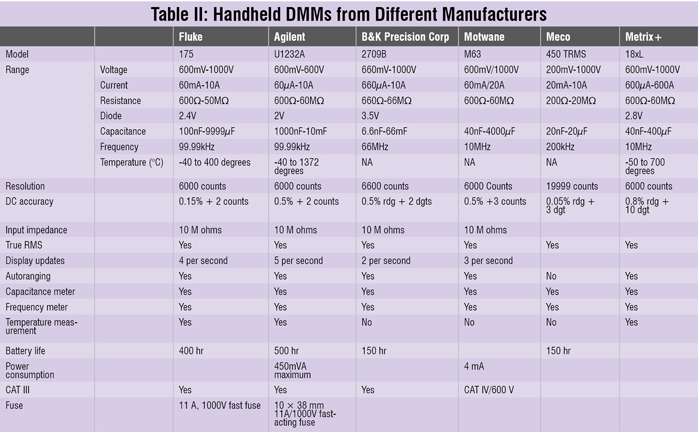Automatic touch hold. A very handy feature for taking measurements at places where both your hands are engaged and you cannot look at the display for the reading. With this feature, you can press the hold button and take the measurement without looking at the display. The measured value will stay there until you reset it. This feature should be automatic, which means that you do not have to press any button to freeze the reading.
Relative measurement. This is a highly useful feature to analyse relative changes in the measured value and/or compensate the losses in the probes.
Min/max mode. This is another essential feature for a DMM. You can hook up the DMM to a circuit and, using this feature, you can get the minimum and the maximum values it records during that period. This feature makes the measurement of min/max very easy as you do not need to continuously look at the display.
Duty cycle measurement. This is really not an essential feature as you will never measure duty cycle of the waveforms using a DMM. There are other equipment for such measurements such as an oscilloscope.
Voltage sense detector. The voltage sense, or the non-contact voltage detector, is an important feature for any person who is likely to come in contact with energised electrical components. For example, Vsense detects the presence of AC voltage in insulated wires, wall receptacles, fuses, junction boxes, switches and other voltage-carrying electrical systems without breaking into the power lines.
Display size, contrast and backlight. It is always better to go for bigger display for clear readings. Also, the contrast of the display should be good. Some cheap Chinese DMMs have very poor display contrast. Backlight comes as a useful feature while taking measurements in dark.
Capacitance, temperature and frequency measurement. Capacitance and temperature measurement are really useful features for a DMM. Though the capacitance measurement is not very accurate in DMMs, and you will need an LCR meter for it, but if you can get the capacitance measurement accuracy up to 2 per cent, you can get reasonably good measurement. These features are highly useful and will reduce the number of test equipment on your table. Frequency measurement is not a highly useful function as you already have oscilloscopes for that. but if you are getting it, look for the highest possible range.

Low-pass filter. The low-pass filter (LPF) function in a DMM is designed to help block unwanted voltages above 1kHz when measuring AC voltage or AC frequency. The LPF can improve measurement performance on composite sine waves that are typically generated by inverters and variable-frequency motor drives.
Data logging. This function is very good for field job where you would want to log your measurements and recall them back when needed. But buy the DMM with data logging facility only when you really need it as it will cause a big price difference.
Fast-response continuity latching. This is one of the features that you are going to use the most. It is useful for tracing tracks, finding shorts and completing hundreds of other tasks. A fast-response continuity latching is must for any DMM. No datasheet will mention it but you will need it, and the troubleshooting will be really annoying if you have a slow-response continuity feature in your DMM.
To test whether the DMM has a fast response, set the DMM in continuity mode and quickly touch the probes to each other. Next touch them very briefly, and you will see the difference between the good one and the average one. The tone should be solid and appear every time you touch the probes. With this function, you can find the shorts on a chip just by wiping the probe across the pins, which is impossible with slow response continuity DMMs.
Select the features that you need from the ones mentioned above to narrow down your choices. Then move to the third step and check various specifications in the datasheet and finalise the values suitable for you.
Range. This specification defines the minimum and maximum of the quantities that can be read without significant errors. This is the first specification that you need to look at while selecting a DMM. The minimum quantity is also critical in selecting the DMM. For example, if you want to work on the low-power circuits, you will have to read the currents in microamperes. So you would require a DMM that can read current values in microamperes too.
Do check the ranges of resistance, capacitance, frequency and temperature also. For regular electronics jobs, the resistance range should be at least 20 mega-ohms. In case of capacitance measurement, smaller the minimum range the better, as nobody will measure very high values of capacitance in electronics. Frequency measurement feature is a bit overrated as nobody will measure frequency using a DMM.






